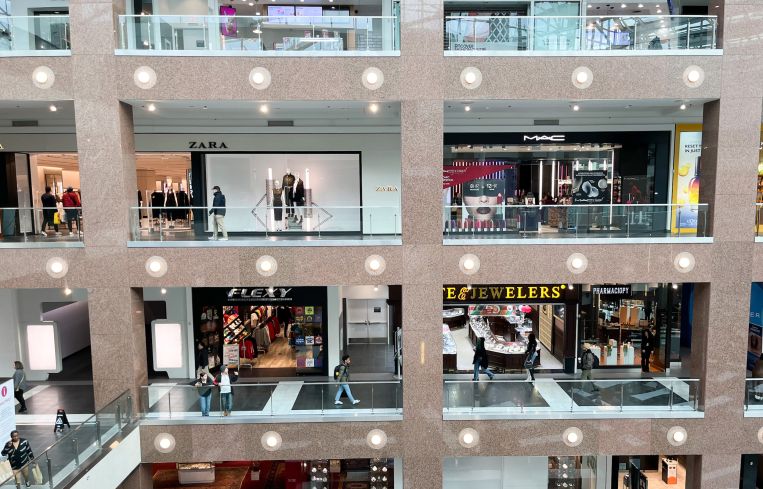National Retail Fundamentals Remain Robust, Even As Uncertainty Takes A Toll
Consumer spending reached its highest point in post-pandemic years, for example, even as sentiment reached its lowest point since 2022
By Nick Trombola May 19, 2025 1:00 pm
reprints
The overall U.S. retail market remained buoyant in the first quarter of this year, with low vacancy rates and mostly stable rent growth, even as economic uncertainty grows due to President Donald Trump’s sweeping tariff policies and stubbornly high interest rates.
Total retail vacancy stayed level at 4.1 percent compared with last quarter, according to a recent market report from JLL, ahead of the annual ICSC conference in Las Vegas (JLL’s report was more bullish compared with a report released by Cushman & Wakefield last week). General retail centers — defined by JLL as freestanding, single-tenant commercial buildings — had the lowest vacancy of all retail subclasses with 2.4 percent this past quarter. Malls were the worst offender with an average vacancy rate of 8.7 percent.
The market recorded stable occupancy despite widescale store closures by companies like Walgreens, Party City and Big Lots in power centers and neighborhood retail complexes. Retail net absorption turned negative in the first quarter of 2025 — the first time in four years — largely driven by those store closures, per JLL. A gloomy topline, perhaps, except for the fact that tight supply for retail space, particularly for retailers looking to expand, means that quality space isn’t available for long.
Of the 17,248 new retail leases signed across the country in the first part of this year, nearly one-third were for space on the market for less than five months. More than half of those deals were closed within 10 months of the initial listing, per JLL. At Party City’s bankruptcy auction earlier this year, for example, nearly one-third of its 695 available leases were snatched up by other retailers, particularly value brands like Dollar Tree.
“Because of these closures, millions of square feet of retail space will return to the market, providing much-needed space to retailers looking to expand,” the report said.
Rent amounts continue to grow, though at a slower pace compared to recent quarters, due at least in part to the large amount of space becoming available. Average rent for U.S. retail space grew by just 0.2 percent quarter-over-quarter, and by 1.8 percent year-over-year. Washington, D.C., perhaps surprisingly, topped the rent growth list of major metropolitan areas, at 5.5 percent compared to the first quarter of 2024. Los Angeles, meanwhile, was second to last on JLL’s list, with an annual rent decline of 0.4 percent.
Still, it’s a far cry from the days when retail was declared all but dead in the wake of both the pandemic and the Great Financial Crisis.
“You will hear a lot of people say that the fundamentals in retail real estate are the best they have ever been,” Kristin Mueller, JLL’s president of retail property management, told Commercial Observer at ICSC. “Retail is outperforming every other property type … everybody wants it … and it’s driving the pricing up because there’s just not enough supply to meet all of the demand. So it’s a very fun time to get involved with retail.”
JLL’s report contains a notable contradiction, however, between the level of monthly consumer spending and consumer sentiment. Monthly spending in March reached its highest point — $734 million — since at least 2018, per JLL, citing U.S. Census data, supported by nonfarm job growth and higher wages outpacing inflation. Yet, consumer sentiment tanked in the first quarter of this year, to its lowest point since 2022, as people showed more and more uneasiness in the face of global tariffs and obstinate interest rates from an unrepentant Federal Reserve.
An anticipation of higher prices in the coming months is behind the discrepancy. Motor vehicles and parts, along with building and garden materials, saw the largest sales bump in March month-over-month, for example. The former jumped 5.3 percent, while the latter rose by 3.3 percent, per JLL.
The U.S. retail investment landscape in the first quarter of 2025 has proved resilient despite the uncertainty. Although investment volume was still far lower than the first quarter of 2022 (given the post-pandemic boom) the $9.8 billion of volume surpassed the comparable quarters of 2024 and 2023 by 13 and 12 percent, respectively. Retail properties in urban centers in particular continue to attract intrigued investors, per JLL. Japan-based fashion brand Uniqlo’s roughly $350 million purchase of its flagship store in New York City last year is evidence of that fact.
Even with millions more square feet set to re-enter the market this year, some retailers and developers may ultimately choose to pause expansion plans as they allow economic conditions to unfold, per JLL’s report. Yet, from Mueller’s perspective, many retailers have begun to accept volatility as a new normal.
“There are some retailers that have slowed some deals, but I’m not aware of any retailers that have flat out said they are stopping deals, that they’re suspending deals,” she said. “But no, nobody is saying we’re stopping all deals wholesale. We’re not going to have more space anytime soon, so [retailers} have to take advantage of the space that’s available today.”
Nick Trombola can be reached at ntrombola@commercialobserver.com.



